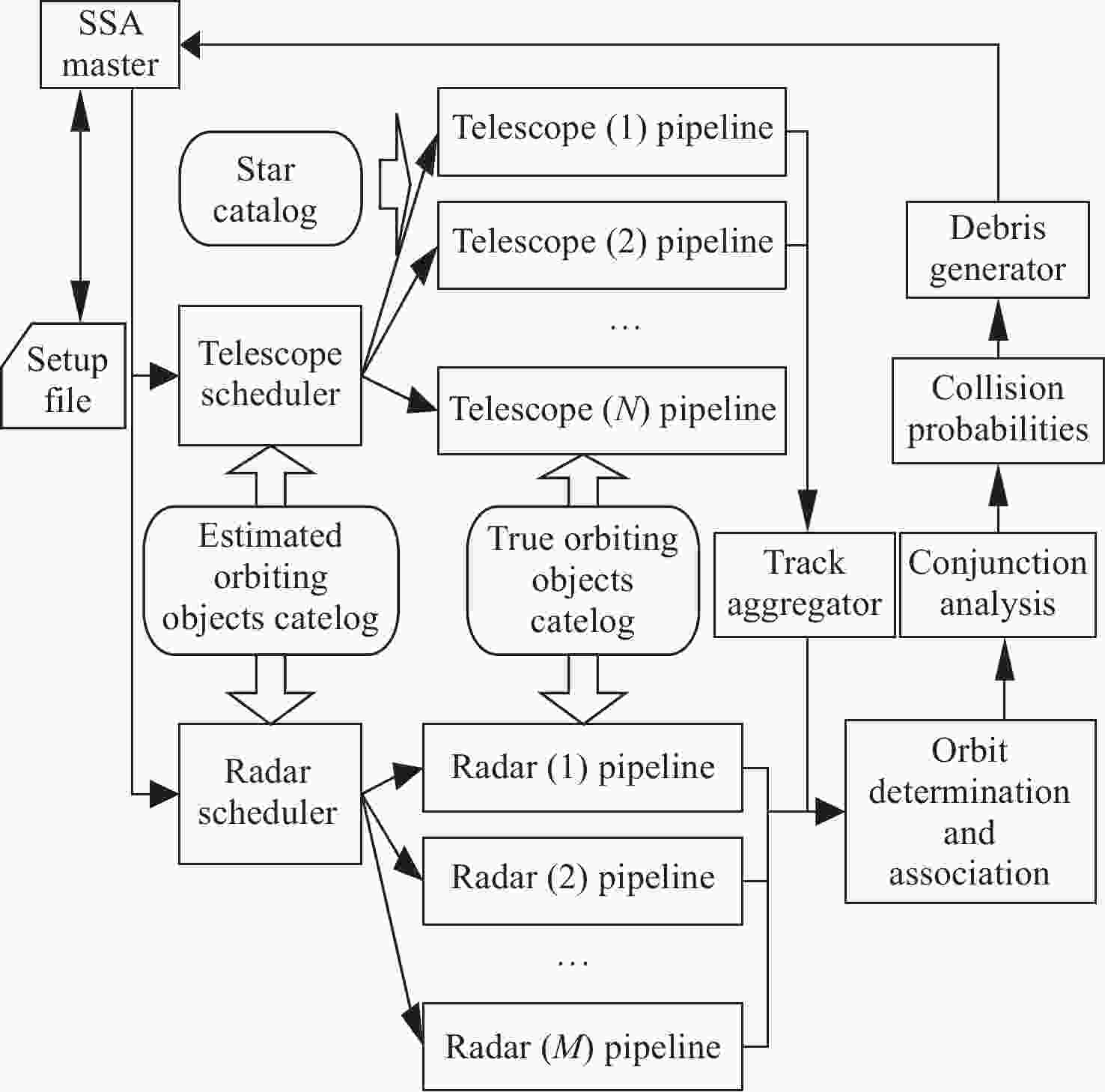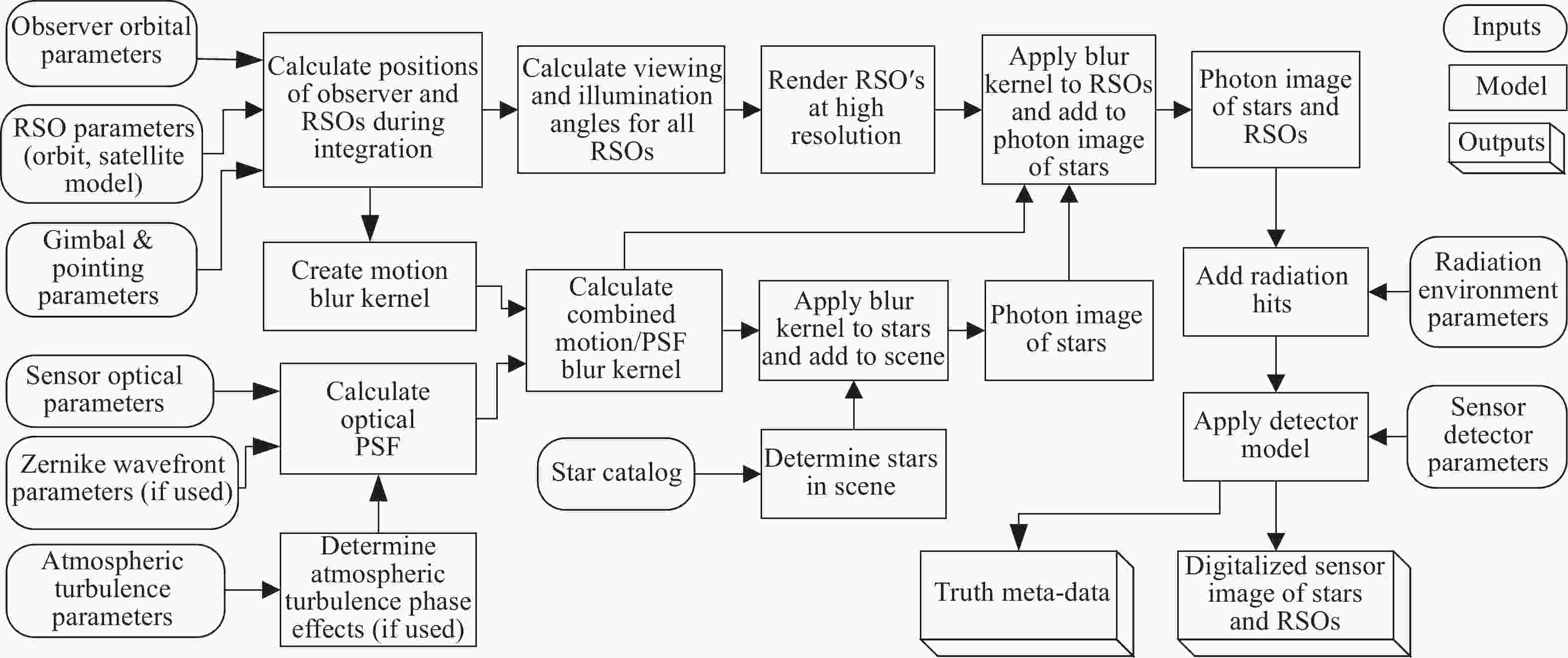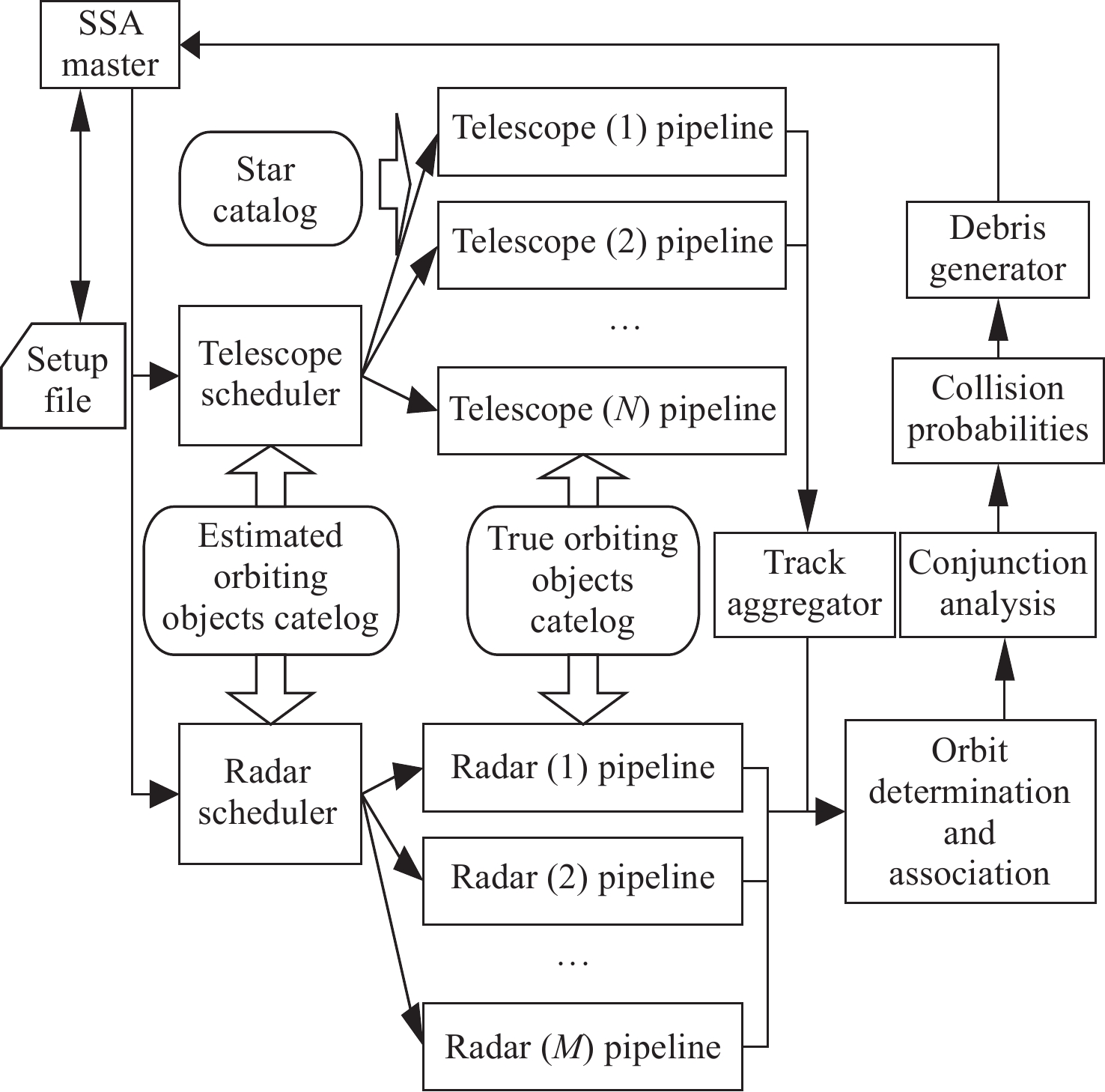-
摘要:
空间态势感知(Space Situational Awareness, SSA)数据仿真可以为空间监测设备及态势感知算法(包括空间目标检测、跟踪、识别和表征)的开发、测试和验证提供关键性数据支持,在空间态势感知能力建设中发挥重要作用。本文以天基空间态势感知光学数据仿真为研究对象,给出了SSA数据仿真的研究目的和主要研究内容,详述了SSA光学成像仿真的典型研究方法与过程。介绍了国内外相关工作的研究现状与工作进展,涵盖双目视觉传感器、激光雷达、红外传感器、可见光望远镜和恒星敏感器等不同光学传感系统的成像建模与仿真工作成果。分析了空间态势感知数据仿真研究的发展趋势,为未来SSA数据仿真研究思路与方法提供参考。
Abstract:The data simulation for Space Situational Awareness (SSA) can provide critical data support for the development, testing, and validation of space surveillance equipment and situational awareness algorithms (including detection, tracking, recognition, and characterization of space object), playing a significant role in building SSA capabilities. Taking the optical data simulation for space-based situational awareness as the research subject, the purpose and main research content of SSA data simulation are presented, and the typical research methods and processes of SSA optical imaging simulation are set forth. The current research status and progress in domestic and foreign related research are introduced, covering the imaging modeling and simulation achievements of different optical sensing systems such as binocular vision sensors, LiDAR, infrared sensors, visible light telescopes, and star trackers. The development trend of SSA data simulation research is analyzed, providing reference for future research ideas and approaches of SSA data simulation.
-
Key words:
- space situational awareness /
- modeling /
- simulation /
- space object /
- imaging
-
[1] HAGERTY S P, ELLIS JR H B. An innovative, high fidelity approach to space situational awareness (SSA) data simulation [C]. 33rd Space Symposium, Technical Track, Space Foundation, 2017: 1-13. [2] RIKER J F, CROCKETT G A, BRUNSON R L. Time-domain analysis simulation for advanced tracking[J]. Proceedings of SPIE, 1992, 1697: 297-309. doi: 10.1117/12.138181 [3] BUSH K A, CROCKETT G A, BARNARD C C. Satellite discrimination from active and passive polarization signatures: simulation predictions using the TASAT satellite model[J]. Proceedings of SPIE, 2002, 4481: 46-57. doi: 10.1117/12.452906 [4] CROCKETT G A, BRUNSON R L. Visualization tool for advanced laser system development[J]. Proceedings of SPIE, 2002, 4724: 69-77. doi: 10.1117/12.472363 [5] AGI: STK EOIR for SSA[EB/OL]. (2023-02-24). https://www.agi.com/resources/documents/eoir. [6] TESSA: tracking space debris[EB/OL]. (2023-09-22). https://computing.llnl.gov/projects/tessa-tracking-space-debris. [7] OLIVIER S S. A simulation and modeling framework for space situational awareness[C]. Advanced Maui Optical and Space Surveillance Technologies Conference, Maui Economic Development Board, 2008. [8] NIKOLAEV S. Optical modeling in testbed environment for space situational awareness (TESSA)[J]. Applied Optics, 2011, 50(22): D21-D26. doi: 10.1364/AO.50.000D21 [9] BERTIN E. SkyMaker: astronomical image simulations made easy[J]. Memorie della Società Astronomica Italiana, 2009, 80: 422-428. [10] HAGERTY S P, ANSARI K. An innovative, near-real-time approach to space situational awareness (SSA) data simulation[C]. 35th Space Symposium, Technical Track, Space Foundation, 2019: 1-18. [11] MITAL R, CATES K, COUGHLIN J, et al. A machine learning approach to modeling satellite behavior[C]. 2019 IEEE International Conference on Space Mission Challenges for Information Technology (SMC-IT), IEEE, 2019: 62-69. [12] BROCHARD R, LEBRETON J, ROBIN C, et al. Scientific image rendering for space scenes with the SurRender software[C]. 69th International Astronautical Congress (IAC), International Astronautical Federation (IAF), 2018: 1-11. [13] LEBRETON J, BROCHARD R, BAUDRY M, et al. Image simulation for space applications with the SurRender software[J]. 11th International ESA Conference on Guidance, Navigation & Control Systems, 2021: 1-16. [14] CLEMENS S, LEE R, HARRISON P, et al. Feasibility of using commercial star trackers for on-orbit resident space object detection[C]. Proceedings of the 19th Advanced Maui Optical and Space Surveillance Technologies Conference, Maui Economic Development Board, 2018: 60-68. [15] CLARK R, FU Y CH, DAVE S, et al. Simulation of RSO images for space situation awareness (SSA) using parallel processing[J]. Sensors, 2021, 21(23): 7868. doi: 10.3390/s21237868 [16] CLARK R, FU Y CH, DAVE S, et al. Resident space object (RSO) attitude and optical property estimation from space-based light curves[J]. Advances in Space Research, 2022, 70(11): 3271-3280. doi: 10.1016/j.asr.2022.08.068 [17] MARTIN I M, DUNSTAN M N, GESTIDO M S. Planetary surface image generation for testing future space missions with PANGU[C]. 2nd RPI Space Imaging Workshop, Sensing, Estimation, and Automation Laboratory, Rensselaer Polytechnic Institute (RPI), 2019: 1-13. [18] PAJUSALU M, IAKUBIVSKYI I, SCHWARZKOPF G J, et al. SISPO: space imaging simulator for proximity operations[J]. PLoS One, 2022, 17(3): e0263882. doi: 10.1371/journal.pone.0263882 [19] CHEN Z, YANG Y, BETTENS A, et al. A simulation-augmented benchmarking framework for automatic RSO streak detection in single-frame space images[J]. Acta Astronautica, 2023: 1-27. [20] 韩意, 孙华燕. 空间目标光学散射特性研究进展[J]. 红外与激光工程,2013,42(3):758-766.HAN Y, SUN H Y. Advances in space target optical scattering character research[J]. Infrared and Laser Engineering, 2013, 42(3): 758-766. (in Chinese). [21] 王阳. 空间群目标的红外辐射与散射特性研究[D]. 西安: 西安电子科技大学, 2015.WANG Y. Radiation and scattering characteristics of space group targets in infrared band[D]. Xi’an: Xidian University, 2015. (in Chinese). [22] 孙成明, 袁艳, 吕群波. 天基空间目标光学散射特性建模与验证[J]. 光学学报,2019,39(11):1129001. doi: 10.3788/AOS201939.1129001SUN CH M, YUAN Y, LÜ Q B. Modeling and verification of space-based optical scattering characteristics of space objects[J]. Acta Optica Sinica, 2019, 39(11): 1129001. (in Chinese). doi: 10.3788/AOS201939.1129001 [23] 李文豪. 天基空间目标红外辐射特性分析与目标工作信息反演[D]. 西安: 中国科学院大学(中国科学院西安光学精密机械研究所), 2018.LI W H. Analysis of space-based space target infrared characteristics and space target working condition inversion[D]. Xi’an: University of Chinese Academy of Sciences (Xi’an Institute of Optics & Precision Mechanics, Chinese Academy of Sciences), 2018. (in Chinese). [24] 汪洪源, 陈赟. 天基空间目标红外动态辐射特性建模与仿真[J]. 红外与激光工程,2016,45(5):0504002. doi: 10.3788/irla201645.0504002WANG H Y, CHEN Y. Modeling and simulation of infrared dynamic characteristics of space-based space targets[J]. Infrared and Laser Engineering, 2016, 45(5): 0504002. (in Chinese). doi: 10.3788/irla201645.0504002 [25] 韩煜. 空间目标可见光特性的研究与仿真及其运动状态辨识[D]. 哈尔滨: 哈尔滨工程大学, 2020.HAN Y. Research and simulation on optical characteristics of space target and motion state identification[D]. Harbin: Harbin Engineering University, 2020. (in Chinese). [26] 李致廷, 刘长明, 王与烨, 等. 基于单光子探测的目标光学散射特性研究[J]. 红外与激光工程,2022,51(9):20210825. doi: 10.3788/IRLA20210825LI ZH T, LIU CH M, WANG Y Y, et al. Research on optical scattering characteristics of targets based on single photon detection[J]. Infrared and Laser Engineering, 2022, 51(9): 20210825. (in Chinese). doi: 10.3788/IRLA20210825 [27] 牛继勇, 李范鸣. 空间目标红外偏振特性分析[J]. 红外技术,2015,37(3):200-203.NIU J Y, LI F M. Analysis to infrared polarization characteristics of space targets[J]. Infrared Technology, 2015, 37(3): 200-203. (in Chinese). [28] 王凯, 刘宏, 张修兴. 空间目标热控涂层材料偏振反射特性研究[J]. 光子学报,2020,49(12):1229003.WANG K, LIU H, ZHANG X X. Study on polarized reflection characteristics of space object thermal control coatings[J]. Acta Photonica Sinica, 2020, 49(12): 1229003. (in Chinese). [29] 韩意, 孙华燕. 空间目标天基光学成像仿真研究进展[J]. 红外与激光工程,2012,41(12):3372-3378.HAN Y, SUN H Y. Advances in space target space-based optical imaging simulation[J]. Infrared and Laser Engineering, 2012, 41(12): 3372-3378. (in Chinese). [30] ZHANG W, JIANG ZH G, ZHANG H P, et al. Optical image simulation system for space surveillance[C]. 2013 Seventh International Conference on Image and Graphics, IEEE, 2013: 721-726. [31] 许兴星, 丁雷. 基于OpenGL的星载可见光相机成像仿真系统[J]. 红外,2017,38(7):15-21.XU X X, DING L. Spaceborne visible light camera imaging simulation system based on OpenGL[J]. Infrared, 2017, 38(7): 15-21. (in Chinese). [32] 卫金鸿. 天基测量相机成像建模与图像仿真[D]. 哈尔滨: 哈尔滨工业大学, 2017.WEI J H. Imaging modeling and image simulation of space-based measurement camera[D]. Harbin: Harbin Institute of Technology, 2017. (in Chinese). [33] HAN Y, LIN L, SUN H Y, et al. Modeling the space-based optical imaging of complex space target based on the pixel method[J]. Optik, 2015, 126(15-16): 1474-1478. doi: 10.1016/j.ijleo.2015.04.034 [34] ZHANG Y, LV L SH, YANG CH L, et al. Research on digital imaging simulation method of space target navigation camera[C]. 2021 IEEE 16th Conference on Industrial Electronics and Applications (ICIEA), IEEE, 2021: 1643-1648. [35] WEN G J, XU Y, LIU CH H, et al. A simulation system of space object images for space situation awareness[C]. 2022 15th International Congress on Image and Signal Processing, BioMedical Engineering and Informatics (CISP-BMEI), IEEE, 2022: 1-6. [36] 狄荣育. 基于PBRT渲染器的空间伴飞目标多光谱成像仿真[D]. 北京: 中国科学院大学(中国科学院国家空间科学中心), 2022.DI R Y. Simulation of multispectral imaging of space accompanying flight targets based on PBRT[D]. Beijing: University of Chinese Academy of Sciences (National Space Science Center, CAS), 2022. (in Chinese). [37] WANG B CH, LI SH, MU J ZH, et al. Research advancements in key technologies for space-based situational awareness[J]. Space: Science & Technology, 2022, 2022: 9802793. [38] UCS Satellite Database. Union of concerned scientists[EB/OL]. (2023-01-01). https://www.ucsusa.org/resources/satellite-database. [39] LANE B, POOLE M, CAMP M, et al. Using machine learning for advanced anomaly detection and classification[C]. 17th Advanced Maui Optical and Space Surveillance Technologies Conference, Maui Economic Development Board, 2016: 1151-1160. [40] DAO P, WEASENFORTH K, HOLLON J, et al. Machine learning-based stability assessment and change detection for geosynchronous satellites[C]. 19th Advanced Maui Optical and Space Surveillance Technologies Conference, Maui Economic Development Board, 2018: 940-953. [41] HUNDMAN K, CONSTANTINOU V, LAPORTE C, et al. Detecting spacecraft anomalies using LSTMs and nonparametric dynamic thresholding[C]. Proceedings of the 24th ACM SIGKDD International Conference on Knowledge Discovery & Data Mining, ACM, 2018: 387-395. [42] JIA B, PHAM K D, BLASCH E, et al. Space object classification using deep neural networks[C]. 2018 IEEE Aerospace Conference, IEEE, 2018: 1-8. [43] LINARES R, FURFARO R, REDDY V. Space objects classification via light-curve measurements using deep convolutional neural networks[J]. The Journal of the Astronautical Sciences, 2020, 67(3): 1063-1091. doi: 10.1007/s40295-019-00208-w [44] KELECY T, HUSSEIN I I, MILLER K, et al. Probabilistic analysis of light curves[J]. The Journal of the Astronautical Sciences, 2019, 66(2): 142-161. doi: 10.1007/s40295-018-0130-3 -






 下载:
下载:



